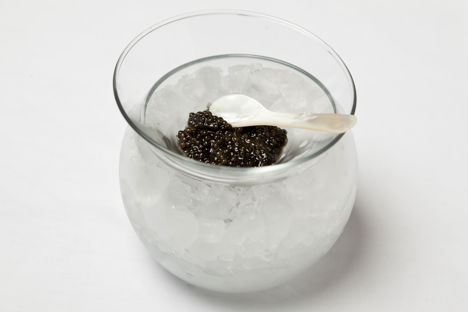
What to serve with caviar
You might think caviar is best enjoyed on its own, but there are certain ingredients and drinks that complement it beautifully without overpowering the flavour. If you’re lucky enough to get your hands on a tin, here’s how to best enjoy one of the most luxurious foods in the world.
What to serve with caviar
You might think caviar is best enjoyed on its own, but there are certain ingredients and drinks that complement it beautifully without overpowering the flavour. If you’re lucky enough to get your hands on a tin, here’s how to best enjoy one of the most luxurious foods in the world.
Whether you’re a Russian oligarch shoving fistfuls of the stuff into your mouth every night or a mere foodie that’s splashed out on a seriously luxurious treat, caviar is something that should be savoured and made the most of. There are tins sold at all price points, containing different varieties, grades and sizes of caviar, but with such a revered product it’s important to know how to serve it (and what to serve with it) so you can enjoy it at its best. And while it may sound counter-intuitive, sometimes serving other foods alongside the delicate eggs can help bring out their famous flavour.
Before you start throwing other things into the mix, however, you’re going to need to know how to serve the caviar itself. The most important rule is to never put metal utensils anywhere near the eggs – the metallic taste seriously affects the pure, saline flavour of caviar and will destroy the subtleties on the palate (which is why the metal tins caviar comes in are lined with plastic on the inside). Instead, use a special caviar spoon, which can be made from bone, plastic or mother of pearl.
Caviar should also be served very cold, so keeping the tin in the fridge and then decanting it into a cold bowl served over ice is best. This exacerbates its refreshing, almost palate-cleansing flavours and will ensure you get the most out of your prized delicacy.
Garnishes
As a very general rule, you should serve less garnishes as the quality of your caviar increases. The finest (and most expensive) caviar really should be at least tried on its own, but if you’re serving more affordable eggs at a party then other ingredients will help bring out the flavour.
Traditionally, caviar is served on top of blinis – mini Russian pancakes made from buckwheat – which act as a mini edible plate with a mild, unobtrusive flavour that are perfect if you’re planning to serve caviar as a canapé. There are also crackers and crispbreads which add a pleasing crunch and still allow the caviar’s flavour to take centre stage. Other simple ingredients like lightly buttered bread and plain boiled potatoes work well too, bulking out the caviar and making it go further.
Other flavours that work well with caviar are hen or quail eggs, raw onion and sour cream. Quite often eggs and onion are finely chopped then used to top blinis with caviar and a small dollop of sour cream. If raw onion sounds a little too harsh, then chives or spring onions are a good alternative.
While a squeeze of lemon works with fish, keep the wedges away from caviar – the juice is simply too overpowering and clashes with its mineral taste. Salt shouldn’t be added either (caviar is naturally slightly salty), nor should any other seasonings. The reason egg, sour cream and blinis work with caviar is because they taste mild and creamy, while the onion should be so finely chopped that it adds just a little sparkle of sweetness. Whether you like to mix all the garnishes together with the caviar and place them on a blini or prefer trying them in different combinations, do make sure you taste the caviar on its own at least once, so you can enjoy the pure flavour on its own.
Of course, you can also use caviar to garnish more adventurous dishes. Simon Hulstone serves his with a Scallop and prawn roulade with a cauliflower purée, while Marcus Wareing puts together a very luxurious starter of Burrata, pea, grapefruit, caviar and leek salad. Many of chef Hideki Hiwatashi’s recipes use caviar as a garnish on top of sushi or other raw fish dishes, while Kevin Mangeolles pairs it with vegetables and dairy in his Organic carrots cooked in goat’s whey with caviar, watercress and goat’s curd.
When it comes to what to drink with caviar, there really are only two choices – Champagne and vodka. It’s really down to personal preference; a small glass of ice cold vodka will complement caviar’s pure, fresh flavours, while Champagne works well with the saltier mineral notes.

